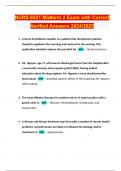Summary
Summary Edexcel A Macroeconomics 4.4 financial markets A* revision notes
Edexcel A Macroeconomics 4.4 financial markets A* revision notes. detailed analysis and evaluation, learn these notes and you will master the content of economics. Easily applicable to any questions if you know the content. This gives you strong A01- knowledge. A03- analysis. A04- evaluation
[Show more]













